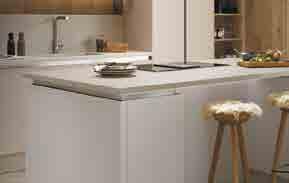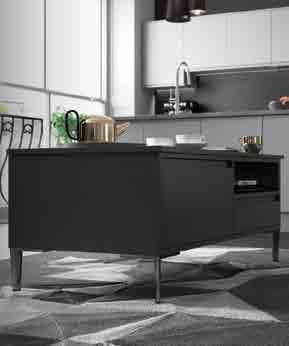
19 minute read
Clifden
from Colourhill Brochure
by LWGB
K1-267
Brushed Satin Brass
K1-170
Rustic Pewter
K1-220
Black
Matte Black
K1-268
Rustic
Antique Copper
K1-159
Polished Polished Nickel
K1-207
Polished Chrome
K1-198
Polished
Polished Nickel Polished Nickel
K1-200
Brushed
Brushed Satin Nickel
K1-199 K1-199
Rustic Rustic
American American American Copper Copper Copper
K1-160
Rustic Pewter
K1-209
Brushed Inox Look Inox Look
K1-158
Rustic
American Copper
K1-219
Brushed Inox Look
K1-208 K1-210
Rustic
Antique Brown
Black
Antique Brown Matte Black Matte Black
K1-273
Brushed
Brushed Brass
K1-275
Brushed Brushed Anthracite

K1-223
Rustic Brass
K1-224
Rustic Copper
K1-276
Black
Brushed Matte Black
K1-263
Brushed
Brushed Nickel Brushed Nickel
K1-261
Brushed Satin Brass
K1-221 K1-222 K1-257
Rustic
Brass
Rustic
Copper
Brushed
Satin Nickel
K1-258
Rustic
Black Nickel Black Nickel
K1-180
Polished Chrome
K1-179
Brushed
Nickel



HANDLELESS RAIL
FURNITURE LEGS
Handleless Rail
Aluminium
FURNITURE LEGS
Our furniture legs have been specially selected to enhance the wide range of complementary furniture pieces that can be created to enhance your living pieces that can be created to enhance your living space and lifestyle.
AY-1LEGBRUSHED
Brushed
Brushed Chrome
AY-1LEGPOLISHED
Polished
Polished Chrome
AY-1LEGBRASS
KITCHEN DOOR CARE & MAINTENANCE CARE & MAINTENANCE


With the appropriate care and maintenance our kitchen doors and components are designed to provide many years of reliable service. To help keep it in the best possible condition please follow the simple guidelines below.
INSTALLATION ADVICE Pre Installation
Ensure that all new-builds or newly plastered rooms have been left to environmentally stabilise prior to the installation of new kitchen doors. Kitchen doors must not be installed into a damp, or moisture-rich environment as it will cause undesirable movement in the joints and panels of the door. A hygrometer should be used to assess conditions.
To help minimise any potential damage to the kitchen whilst you are installing it, please read and adhere to the following instructions and recommendations:
• We would advise that you make an initial check to confi rm that you have the correct quantity and sizes of fascias; you can do this by referring to the labels attached to the outer packaging.
• The fascias should be stored fl at and away from the working area. Take extreme care when stacking the fascias with hinges attached to ensure that the hinges do not mark other fascias. Do not lean the fascias against one another, or against any surface without proper protection in-between.
• Ensure that you fully inspect each individual fascia prior to attaching the hinges. Claims for damage to the fascia will not be accepted after the hinges have been attached.
• Take extreme care when unpacking the fascias and do not use sharp blades to cut away the packaging.
• When attaching the hinges, place the fascia face down on a soft clean surface, ensuring that there is no grit, sawdust or other matter underneath that could damage the surface of the fascia whilst the hinges are attached. It is good practice to place a sheet of clean cardboard between the fascia and the fl at surface prior to attaching the hinges.
• If the hinges are ‘knock-in’ type, use a rubber mallet to knock the hinges into the fascia without using excessive force.
• Once the hinges have been attached to a door, hang the door on the unit straight away to avoid damage. Do not stack the doors with the hinges touching other doors, as this can cause scratches or marks to the other fascias.
• Do not stack the doors on their ends on any hard surface; this can cause chipping and scratching along the edge of the fascia, especially on the handle edge of ranges with an integral handle. Prior to fi tting, the fascias should be stored fl at, ensuring that they are not resting on any dirt or debris that may damage or mark the fi nish.

• You should take extreme care not to put the door down with excessive force on any edge, especially the handle edge, as this will cause crushing/impact damage on these edges.
• Take extreme care not to put the door down on any hard or rough surface such as bare concrete fl oors, or on any debris such as sawdust, grit or screws, as this can damage the product.
• If the fascias are attached to the carcass, then you should carefully remove the fascias by unclipping the hinges, and storing these fl at in a clean safe environment away from your working area, utilising the packing materials from the units. • Where cutting/scribing décor panels and trim, you must use a sharp quality saw blade of the appropriate grade for fi ne-cutting, or a suitable router. Small chips can appear along the cut-edge, and so extra care must be taken to minimise the risk of chipping. Using a blunt or inappropriate saw blade will produce a poor fi nish, and this will not be covered by the guarantee.
• On Painted Products: Any fi ne chips along the cut edge should be smoothed with a fi ne grade sand paper prior to fi tting.
• All cut edges should be sealed against moisture ingress using a suitable water resistant sealant/adhesive prior to installation.
• All trims are supplied in long lengths and need to be cut down on site, and again it is important that this is done using the appropriate tools.
• When fi tting the plinth, ensure that you check the dimensions of any adjacent appliances. On occasion, the plinth may need to be pulled forward to ensure that it clears the front of the appliance. This can be achieved by fi tting blocks using off -cuts to the rear of the plinth prior to attaching the plinth clips, to step the plinth forward from its normal position.
General Care
As with all kitchen furniture the most common problems found occur as a result of excessive or prolonged exposure to heat and/or moisture. Always ensure that water is not left around sink areas as damage caused as a result is not covered by the guarantee.
Always wipe off excess moisture and be careful with extreme heat sources, such as kettles, ovens and toasters. It is recommended that these heat sources are not placed directly under wall units when they are in use; they generate a higher level of heat and moisture than is often appreciated and can quickly and easily lead to damage of the furniture.
Don’t place appliances that create steam (e.g. steamer, coff ee maker or kettle) underneath the cabinets so that the steam fl ows up against the underside of the cabinet and doors.
If using glass cleaner to clean your glass doors be careful not to damage the fi nish of the door and cabinet parts while cleaning. Do not spray glass cleaner directly on to the glass or cabinet parts as this may discolour the fi nish of your kitchen cabinets. Instead, spray a small amount of cleaner on to a lint free cloth or paper towel then wipe the glass.
Don’t open the door of the dishwasher immediately after the programme has ended, as exposure to heat and the high humidity increases the risk that the door may absorb moisture and swell.
Please note that after a period of time it is quite normal for the colouring of kitchen units to mellow in colour. This is not a manufacturing fault and is as a result of exposure to light. This means that any additional parts subsequently ordered for your kitchen, or supplied as replacements may not be an exact colour match. However any additional parts supplied will also mellow over time to blend with your existing units.
The colour of doors and drawer fronts may appear mismatched in colour. This apparent mismatch is sometimes the eff ect of diff ering light conditions within your kitchen, (known as metamerism). To check your doors and fascia you should place them side by side in natural daylight for comparison.
Cleaning advice for all door types including timber, painted & foil
• Do not use wax-furniture polish, abrasive or aggressive cleaners, bleach or other hypochlorite (chlorine) based cleaners, multipurpose cleaners, dilutes, acetone, alcohol, solvent or similar products on the door, as this will damage the surface; additionally wax and polishes leave a residue build up that is diffi cult to remove.
• Only use a 5% soap, 95% water (liquid soap) solution, wiping with a damp (not wet) cloth, fi nally drying with a soft clean cloth.
• Ensure all cooking splashes are wiped immediately with a damp cloth; and dust with a soft cloth only.
• Never use any abrasive pads or abrasive cleaners on the furniture. Spills and condensation on the fascias/panels should be cleaned and dried immediately.
Timber & Veneered Doors
Cleaning: when cleaning timber doors you must follow the pattern of the grain. It is advisable to use a damp (not wet) cloth to remove fi ngerprints and marks, followed at once with a clean and dry soft cloth.
Moisture: excess moisture can damage a timber product - it is recommended that susceptible areas such as around the sink are thoroughly maintained and kept dry at all times.
Light: timber changes colour when exposed to light. Light, lacquered surfaces also have a certain tendency to “yellow with age” depending on the exposure to light. The species of timber and intensity of exposure will aff ect the rate of change. Due to this we recommend that timber samples be changed regularly.
It is advised that colour change is taken into consideration when replacing or fi tting new doors some time after the original kitchen has been installed.
Foil & High Gloss Finished Doors
Foil/Lacquer coated products are manufactured from the highest quality materials. Please be careful not to puncture the foil/melamine lacquered surface of your panels. These should be kept dry in order to prevent moisture ingress.

Your gloss doors will come with a protective fi lm over the front. You should remove this only after they are installed as the curing process continues for around 72 hours after the fi lm is removed. This means the doors will be liable to scratching and other marks. You should avoid cleaning the doors for at least a few days to prevent any marks appearing on the surface.
You should clean the doors with a soft damp cloth and a mild detergent. Never use any harsh or abrasive cleaners as this may damage the gloss surface of the door. Normal cleaning and polishing may leave minor scratches on the surface of the door, which is quite natural.
Moisture: Periodically clean the interior and exterior surfaces of the door using a soft, damp cloth. Wipe dry all surfaces after cleaning.
Use only cleaning agents that are intended for the materials used in your kitchen. Avoid any agents that contain ammonia, alcohol, bleach or an abrasive.
If the surface of the product is exposed to any oil based substance (for example olive oil, butter, margarine or cooking oil), the spillage must be wiped away immediately to prevent staining. Grease marks caused by these oil-based products can easily be removed by use of a mild detergent, non-abrasive cleaner if used immediately after spillage has happened.
Abrasive cleaners are not recommended for this type of product. Do not expose the doors or panels to a temperature in excess of 60°C (140°F) (Approximately the temperature of washing up water).
Light: If the doors are supplied with a protective fi lm on the face they must not be directly exposed to sunlight. Once installation is complete, carefully remove the protective fi lm from the front of the fascia. We also advise that colour change is taken into consideration when replacing or fi tting new doors some time after the original kitchen has been installed.
Painted Doors
Cleaning: it is advisable to use a damp (not wet) cloth to remove fi ngerprints and marks, followed at once with a clean and dry soft cloth. Any form of furniture polish or other cleaning products should be avoided.
Light: painted fi nishes will change colour when exposed to light - the intensity of exposure will aff ect the rate of change. Any colour samples and door samples provided should be used as a guide only and due to certain variables, may not provide an exact match to the fi nished painted product.
We also advise that colour change is taken into consideration when replacing or fi tting new doors some time after the original kitchen has been installed.
have the correct quantity and sizes of fascias; you can do this by referring to the labels attached to the outer packaging. • The fascias should be stored fl at and away from the working area. Take extreme care when stacking the fascias with hinges attached to ensure that the hinges do not mark other fascias. Do not lean the fascias against one another, or against any surface without proper • Ensure that you fully inspect each individual fascia prior to attaching the hinges. Claims for damage to the fascia will not be accepted after the hinges have been attached. • Take extreme care when unpacking the fascias and do not use sharp blades to cut away the packaging. • When attaching the hinges, place the fascia face down on a soft clean surface, ensuring that there is no grit, sawdust or other matter underneath that could damage the surface of the fascia whilst the hinges are attached. It is good practice to place a sheet of clean cardboard between the fascia and the fl at surface prior to • If the hinges are ‘knock-in’ type, use a rubber mallet to knock the hinges into the fascia without using excessive force. • Once the hinges have been attached to a door, hang the door on the unit straight away to avoid damage. Do not stack the doors with the hinges touching other doors, as this can cause scratches or can cause chipping and scratching along the edge of the fascia, especially on the handle edge of ranges with an integral handle. Prior to fi tting, the fascias should be stored fl at, ensuring that they are not resting on any dirt or debris that may damage or mark excessive force on any edge, especially the handle edge, as this surface such as bare concrete fl oors, or on any debris such as sawdust, grit or screws, as this can damage the product. • If the fascias are attached to the carcass, then you should carefully remove the fascias by unclipping the hinges, and storing these fl at in a clean safe environment away from your working area, utilising • Where cutting/scribing décor panels and trim, you must use a sharp quality saw blade of the appropriate grade for fi ne-cutting, or a suitable router. Small chips can appear along the cut-edge, and so extra care must be taken to minimise the risk of chipping. Using a blunt or inappropriate saw blade will produce a poor fi nish, and this will not be covered by the guarantee. • On Painted Products: Any fi ne chips along the cut edge should be smoothed with a fi ne grade sand paper prior to fi tting. • All cut edges should be sealed against moisture ingress using a suitable water resistant sealant/adhesive prior to installation. • All trims are supplied in long lengths and need to be cut down on site, and again it is important that this is done using the appropriate tools. • When fi tting the plinth, ensure that you check the dimensions of any adjacent appliances. On occasion, the plinth may need to be pulled forward to ensure that it clears the front of the appliance. This can be achieved by fi tting blocks using off -cuts to the rear of the plinth prior to attaching the plinth clips, to step the plinth forward from its normal position.
General Care
As with all kitchen furniture the most common problems found occur as a result of excessive or prolonged exposure to heat and/or moisture. Always ensure that water is not left around sink areas as damage caused as a result is not covered by the guarantee. Always wipe off excess moisture and be careful with extreme heat sources, such as kettles, ovens and toasters. It is recommended that these heat sources are not placed directly under wall units when they are in use; they generate a higher level of heat and moisture than is often appreciated and can quickly and easily lead to damage of the furniture. Don’t place appliances that create steam (e.g. steamer, coff ee maker or kettle) underneath the cabinets so that the steam fl ows up against the underside of the cabinet and doors. If using glass cleaner to clean your glass doors be careful not to damage the fi nish of the door and cabinet parts while cleaning. Do not spray glass cleaner directly on to the glass or cabinet parts as this may discolour the fi nish of your kitchen cabinets. Instead, spray a small amount of cleaner on to a lint free cloth or paper towel then wipe the glass. Don’t open the door of the dishwasher immediately after the programme has ended, as exposure to heat and the high humidity increases the risk that the door may absorb moisture and swell. Please note that after a period of time it is quite normal for the colouring of kitchen units to mellow in colour. This is not a manufacturing fault and is as a result of exposure to light. This means that any additional parts subsequently ordered for your kitchen, or supplied as replacements may not be an exact colour match. However any additional parts supplied will also mellow over time to blend with your existing units. The colour of doors and drawer fronts may appear mismatched in colour. This apparent mismatch is sometimes the eff ect of diff ering light conditions within your kitchen, (known as metamerism). To check your doors and fascia you should place them side by side in natural daylight for comparison.
Cleaning advice for all door types including timber, painted & foil
• Do not use wax-furniture polish, abrasive or aggressive cleaners, bleach or other hypochlorite (chlorine) based cleaners, multipurpose cleaners, dilutes, acetone, alcohol, solvent or similar products on the door, as this will damage the surface; additionally wax and polishes leave a residue build up that is diffi cult to remove. • Only use a 5% soap, 95% water (liquid soap) solution, wiping with a damp (not wet) cloth, fi nally drying with a soft clean cloth. • Ensure all cooking splashes are wiped immediately with a damp cloth; and dust with a soft cloth only. • Never use any abrasive pads or abrasive cleaners on the furniture. Spills and condensation on the fascias/panels should be cleaned and dried immediately.
Timber & Veneered Doors
Cleaning: when cleaning timber doors you must follow the pattern of the grain. It is advisable to use a damp (not wet) cloth to remove fi ngerprints and marks, followed at once with a clean and dry soft cloth. Moisture: excess moisture can damage a timber product - it is recommended that susceptible areas such as around the sink are thoroughly maintained and kept dry at all times. Light: timber changes colour when exposed to light. Light, lacquered surfaces also have a certain tendency to “yellow with age” depending on the exposure to light. The species of timber and intensity of exposure will aff ect the rate of change. Due to this we recommend that timber samples be changed regularly. It is advised that colour change is taken into consideration when replacing or fi tting new doors some time after the original kitchen has been installed.
Foil & High Gloss Finished Doors
Foil/Lacquer coated products are manufactured from the highest quality materials. Please be careful not to puncture the foil/melamine lacquered surface of your panels. These should be kept dry in order to prevent moisture ingress. Your gloss doors will come with a protective fi lm over the front. You should remove this only after they are installed as the curing process continues for around 72 hours after the fi lm is removed. This means the doors will be liable to scratching and other marks. You should avoid cleaning the doors for at least a few days to prevent any marks appearing on the surface. You should clean the doors with a soft damp cloth and a mild detergent. Never use any harsh or abrasive cleaners as this may damage the gloss surface of the door. Normal cleaning and polishing may leave minor scratches on the surface of the door, which is quite natural. Moisture: Periodically clean the interior and exterior surfaces of the door using a soft, damp cloth. Wipe dry all surfaces after cleaning. Use only cleaning agents that are intended for the materials used in your kitchen. Avoid any agents that contain ammonia, alcohol, bleach or an abrasive. If the surface of the product is exposed to any oil based substance (for example olive oil, butter, margarine or cooking oil), the spillage must be wiped away immediately to prevent staining. Grease marks caused by these oil-based products can easily be removed by use of a mild detergent, non-abrasive cleaner if used immediately after spillage has happened. Abrasive cleaners are not recommended for this type of product. Do not expose the doors or panels to a temperature in excess of 60°C (140°F) (Approximately the temperature of washing up water). Light: If the doors are supplied with a protective fi lm on the face they must not be directly exposed to sunlight. Once installation is complete, carefully remove the protective fi lm from the front of the fascia. We also advise that colour change is taken into consideration when replacing or fi tting new doors some time after the original kitchen has been installed.
Painted Doors
Cleaning: it is advisable to use a damp (not wet) cloth to remove fi ngerprints and marks, followed at once with a clean and dry soft cloth. Any form of furniture polish or other cleaning products should be avoided. Light: painted fi nishes will change colour when exposed to light - the intensity of exposure will aff ect the rate of change. Any colour samples and door samples provided should be used as a guide only and due to certain variables, may not provide an exact match to the fi nished painted product. We also advise that colour change is taken into consideration when replacing or fi tting new doors some time after the original kitchen has been installed.




